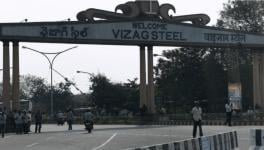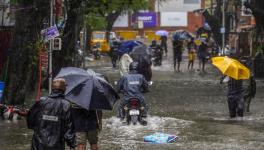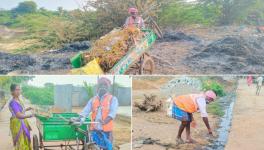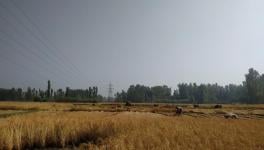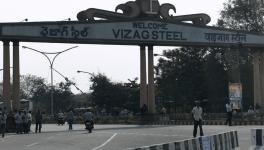Phailin Cyclone: A Relief in India's Disaster
Prabir Purkayastha from Newsclick discusses the Phailin cyclone with D. Raghunandan from Delhi Science Forum. Mr. Raghunandan says Odisha's government has done a commendable job in saving thousands of lives. He also goes on to compare their preparedness with the complete lax attitude of the Uttarakhand government in dealing with the recent natural disaster.
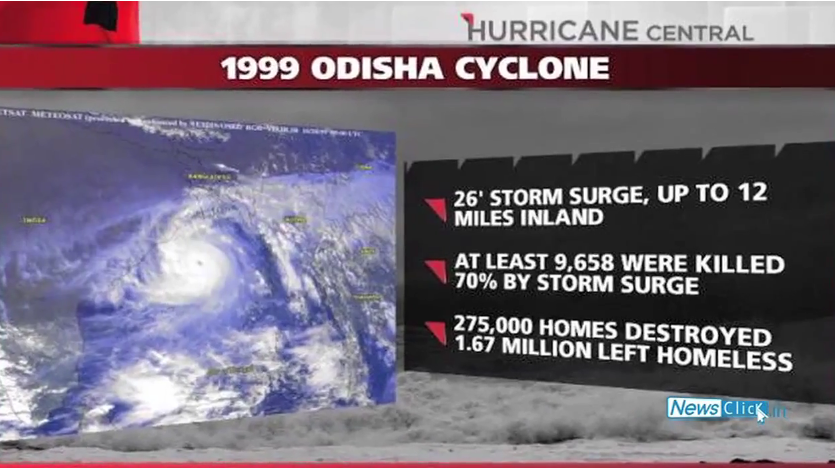
Prabir Purkayastha (PP): Hello and welcome to Newsclick. Today we have with us D. Raghunandan, President of All India People's Science Network, to discuss [the] latest tropical storm or cyclone – Phailin. Raghu, good to have you with us. This time the scale of disaster has been considerably less in terms of people killed than the earlier 1999 cyclone that hit Orissa, and also the much earlier one which had hit Andhra Pradesh. Do you think this time the government of India, the disaster management system has been much better equipped?
D. Raghunandan (DR): Certainly. They have learnt their lessons the hard way from 1999 where more than 10,000 lives were lost. And what they have essentially done is to have... they've built new storm shelters all along the coast, dotted on the coasts. Plus, they have identified school buildings and other government structures as storm shelters. So they had got good advance warning of the cyclone this time, and based on that they decided to go in for mass evacuation, if necessary by force. They compelled people who were even unwilling to move out from the coastal areas, not very far, but they took them by buses and trucks into storm shelters which are essentially fairly large 'pucca' buildings – brick and cement and mortar structures – which had been very well organized with bedding, places to sleep, food for the people who had taken shelter. A total of close to 900 thousand people were evacuated and taken to storm shelters in Orissa and Andra.
PP: That is a very large number.
DR: Huge number. That's massive. And that has been the major reason why they had taken as a priority 'we may not be able to do much to save property and 'kuchcha' houses, but let's save lives', and that I think has worked out well. And it was done very well, coordinated very well. To me it shows, when India wants to do something, it can. So wherever we don't see it happening, it shows that there has been lack of attention to that.
PP: And also the fact that there was an early advanced planning done from long before.
DR: That's right.
PP: So there was this expectation that if a cyclone takes place, what is it that we need to do.
DR: That's right.
PP: Taken... Given that as it may be, there's also some dispute about the cyclone itself.
DR: Sure.
PP: There are a lot of people who call it a super cyclone, predicted wind speeds above 250 kms.
DR: Sure.
PP: This appears to be a very big cyclone, but not a super cyclone.
DR: Well, it was cyclone on a scale of 1 to 5, which is the normal thing which is measured, the super cyclone is classified as category 5 cyclone. This one was a category 4 cyclone. Now, it looks like a big difference. Frankly speaking, it's not that big in the sense, a category 5 [correction: category 4] cyclone, [you'd] expect wind speeds of 200 to 220 kilometres per hour. A category 5, you'd expect wind speeds of 250 kilometres an hour.
PP: So anything above 220 is... will be categorized as 5.
DR: That's right. Now what had happened was that the Joint Tropical Weather Centre... the Joint Typhoon Weather Centre in the US had classified it as category 5. And till about three days ago, it had actually reached category 5 and then it slowed down. So it was category 4 when it actually hit the Orissa coast.
PP: So when it made landfall, the speeds were low...
DR: ...it was category 4 and for about a day before that. However, I must add that the IMD, I think, had done a better job of tracking and classifying the cyclone probably because it had better data this time than the normally reliable US Joint Typhoon Weather Centre . Partly because the data that the IMD had was also based on local... you would remember that after the Tsunami, India had installed a large number of buoys in the Arabia Sea.
PP: And on the Indian Ocean.
DR: Oh... and on the Indian Ocean. So this chain buoys that had been set up which then send signals up into satellite, which are then received in the control centre enabled IMD to track the cyclone and to give a more accurate reading of the cyclone's progress and its strength than I think other stations will have...
PP: A lot of it is advanced preparation again in the wake of the advanced Tsunami as you rightly pointed out. And also the fact that cyclone is something that periodically happens...
DR: That's right.
PP: ...in this whole coast, starting from Bengal to...
DR: That's right.
PP: ...Andhra Pradesh, even down to Tamil Nadu. So this time preparation showed that this has been partially successful, of course there could be things which could be improved.
DR: Sure.
PP: Property, etc. are something that would be very difficult to do anything about.
DR: That's right.
PP: Unless you change the housing codes and, more important, people have the money. And this population really is a question of... that they don't really have the money.
DR: In Ganjam district alone, 250 thousand 'kuchcha' houses along the coast, belonging to fishermen, and the poor people... obviously, in 220 kilometre winds, not a single one of those structures is going to survive.
PP: And 45,000 electricity poles have been completely destroyed in Andhra Pradesh.
DR: That's right.
PP: We don't have full reports of...
DR: That's right. We don't have...
PP: So there are obviously large scale devastation that has taken place to infrastructure, to houses and so on. Tress uprooted.
DR: That's right.
PP: But at least lives have been saved.
DR: Lives have not... That's a big thing.
PP: Coming to the question that you'd raised earlier about India's will to do things, Uttarakhand was really a contrast where the disaster management failed completely. And what is now being said, of course it's not admitted by the government as yet, but the team monitoring the glacial melts was really not in place though they were supposed to be there. And also therefore there was no advance warning. So does it show that disaster management in Uttarakhand was far worse – A. Preparations were much worse. And also the necessary warnings were not issued.
DR: Absolutely. On both counts, I think. One is the early warning structures, systems, infrastructure... whether they are in place or not. And clearly in Uttarakhand, they were not.
PP: Interesting part is that apparently a group of people who are supposed to monitor the glacier...
DR: That's right.
PP: ...whose melting due to the rains is really what caused the overflow of the lake and then the further disaster. People who were supposed to be there but they obviously were either missing or they did inform and that information was not acted upon.
DR: There was one team which had actually reached the lake and they found that it was in danger of overflowing. But communications had broken down. They couldn't get the message down. They tried to actually reach by foot. By the time they reached by foot to Kedarnath, they...
PP: Water had already reached there.
DR: Water had already reached the temple town. So, on the one hand, there is this early warning part of it. And the preparedness is not only by early warning, it's by what you do when you know that what is expect is going to happen. And that was completely absent in Uttarakhand. For example, here in Orissa and Andhra Pradesh, knowing that this going to happen, they already had some infrastructure available in the form of the storm shelters. Five days before when they knew the strength of the cyclone that was going to hit, they arranged buses and trucks, and trucked people out into safer areas. Nothing of this kind either existed or was attempted in Uttarakhand. Incidentally, it also shows one of the big advantages which enables you to do what you are able to do in Orissa and Andhra is the availability of good roads, good communication infrastructure, trucks and buses and roads which can take heavy vehicles. And you would know that many environmentalists are clamouring in Uttarakhand for not building roads and so on. And you can imagine how much worse things could have been or would be in future if we don't have sufficiently strong and good road infrastructure in the hills to be able to evacuate people or take them to safer zones. The other thing is the construction of shelters which is required in Uttarakhand where attention has not been paid to that aspect.
PP: Location as well as the construction of shelters. But it does point out that if advanced preparations are made, plans for disaster management are there, and advanced warning systems built, the way it has been built now for cyclones, we can see, then future disasters like the Uttarakhand can be mitigated. That's...
DR: I will add one point to the list that you enumerated and that is, whether these plans and proposals are implemented well. Because as we know in India, we are fairly good at making plans. We are not particularly good at implementing them.
PP: But in Uttarakhand the plans were also not there.
DR: Even the plans were not there.
PP: To be fair, the infrastructure was not there.
DR: Exactly. And what I think Orissa and Andhra response to the cyclone has shown was that there was actually excellent implementation of these plans. People were actually moved. They were actually taken to the cyclone shelters. The cyclone shelters were well-equipped with bedding, medication, food and there were people... staff in each of these shelters who were cooking food and supplying it to the people. Now, that shows very effective coordination particularly by the district administration and by the staff around that. And that has been very effective. Which also of course, as we know, collapsed in Uttarakhand.
PP: Last point on this. You know, Uttarakhand... a very heavy rain... rainfall that occurred. And this kind of cyclones. This is supposed to be the kind of winds that were there at least... when the cyclone was over the Bay of Bengal... when, you said, the wind speed really went up, would make it one of the strongest cyclones for the last decade.
DR: That's right.
PP: Do you think these are extreme weather events we're seeing as a consequence of climate change, particularly because IPCC has said that one of the clear indicators of global warming is ocean warmth? And will that indicate the cyclones will be more frequent and would be actually stronger?
DR: Very difficult to say because the IPCC report... the fifth assessment report which has recently been published also says that compared to many other indicators of extreme weather, the co-relation between the tropical cyclone’s intensity and frequency and climate is only of medium confidence, they are able to predict. They are not able to predict with a very high degree of confidence as to the co-relation to climate. There could be many other factors involved. So they are not very sure how much climate change has played a role in these, or not.
PP: So extreme weather events increasing, yes. But we cannot draw a conclusion of a one to one co-relation between a strong cyclone and climate change.
DR: Or even the increased frequency of these cyclones which seems to have been observed, but I think statically that is not as significant yet. But you never know. The IPCC, in further observations, may update this in time to come.
PP: But apart from that, high frequency events or extreme events have been increasing, so that is something...
DR: Extreme rainfall events definitely have increased, and there is a very good co-relation on that. Cyclones, we are not yet sure.
PP: Thank you very much Raghu. Hope that we can discuss these issues further. Thank you.
Get the latest reports & analysis with people's perspective on Protests, movements & deep analytical videos, discussions of the current affairs in your Telegram app. Subscribe to NewsClick's Telegram channel & get Real-Time updates on stories, as they get published on our website.










